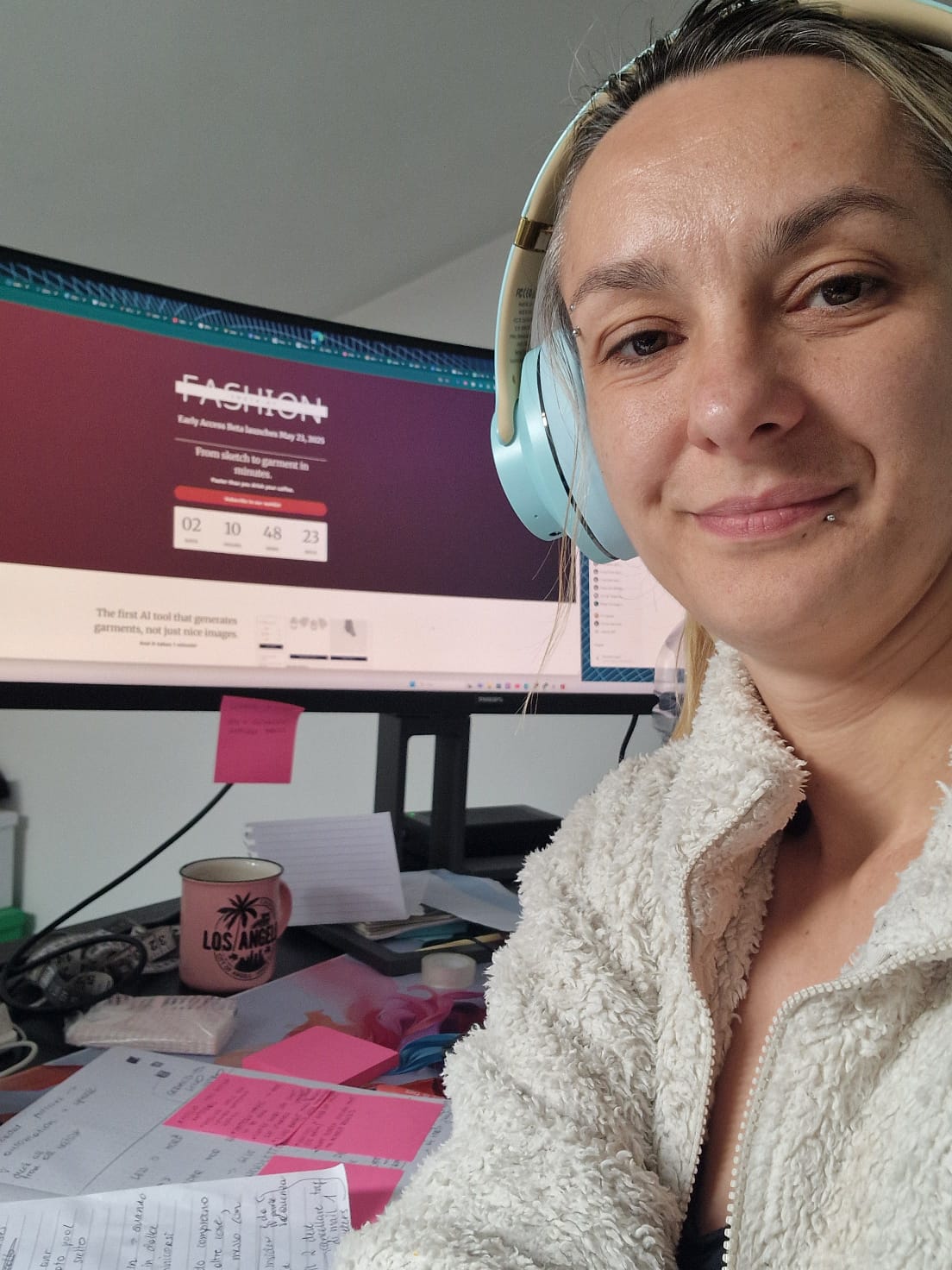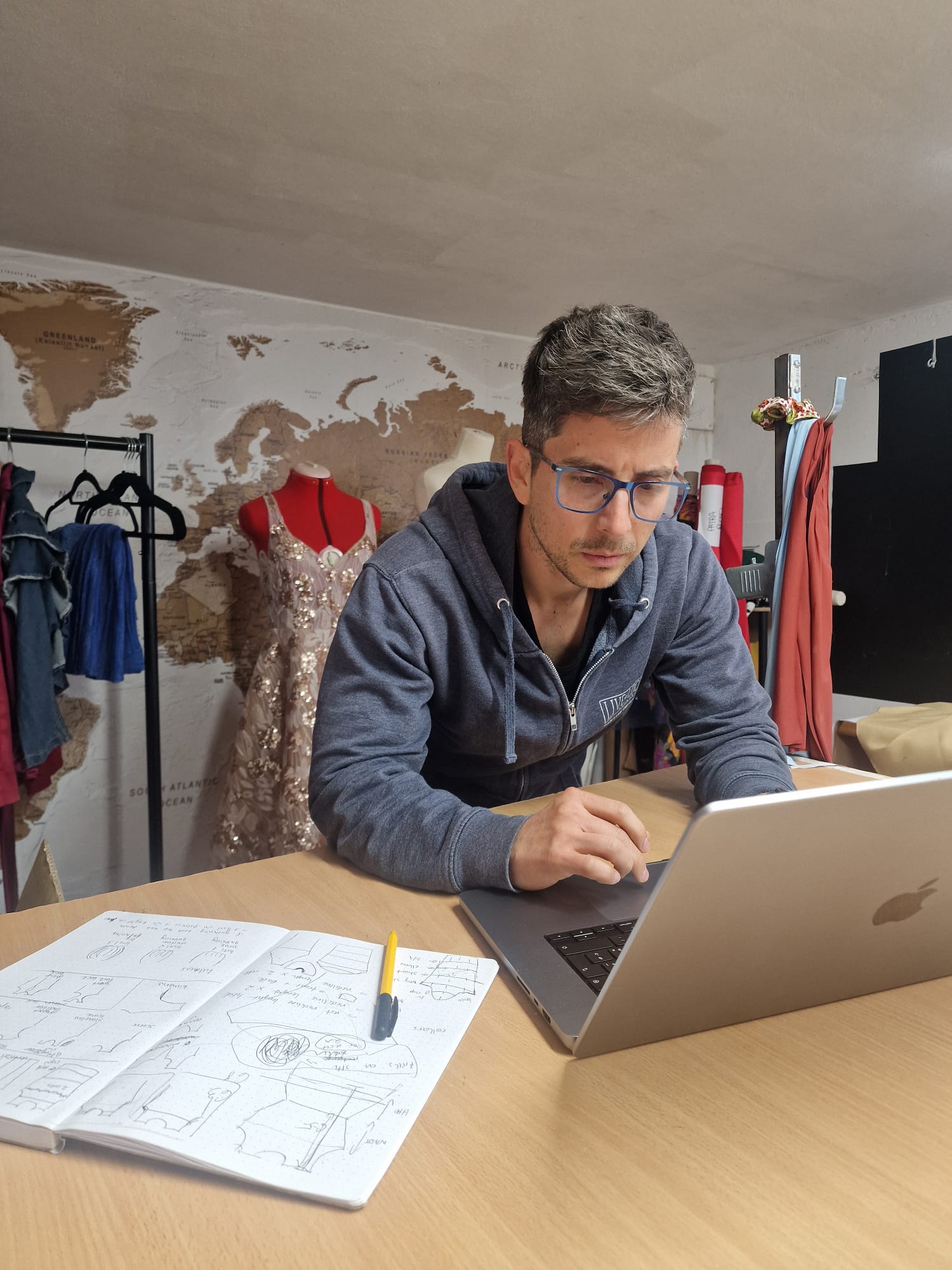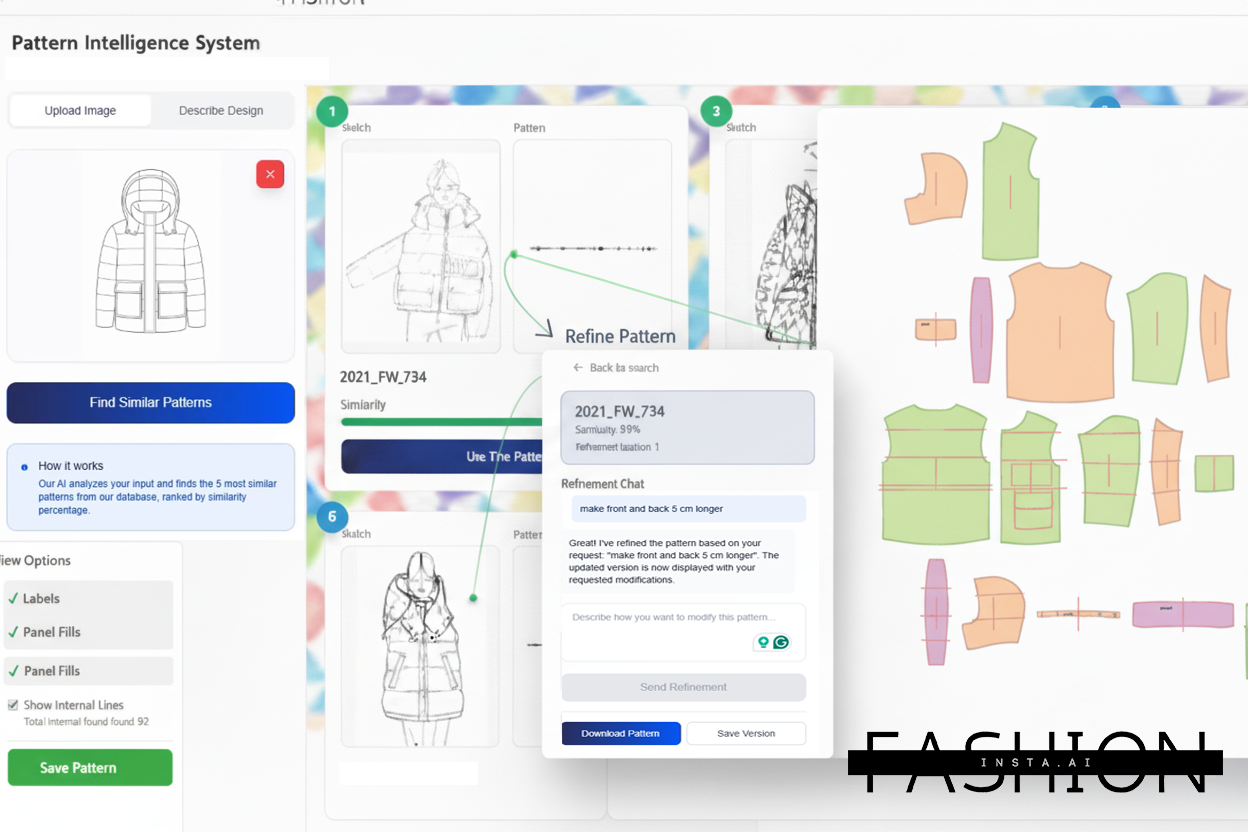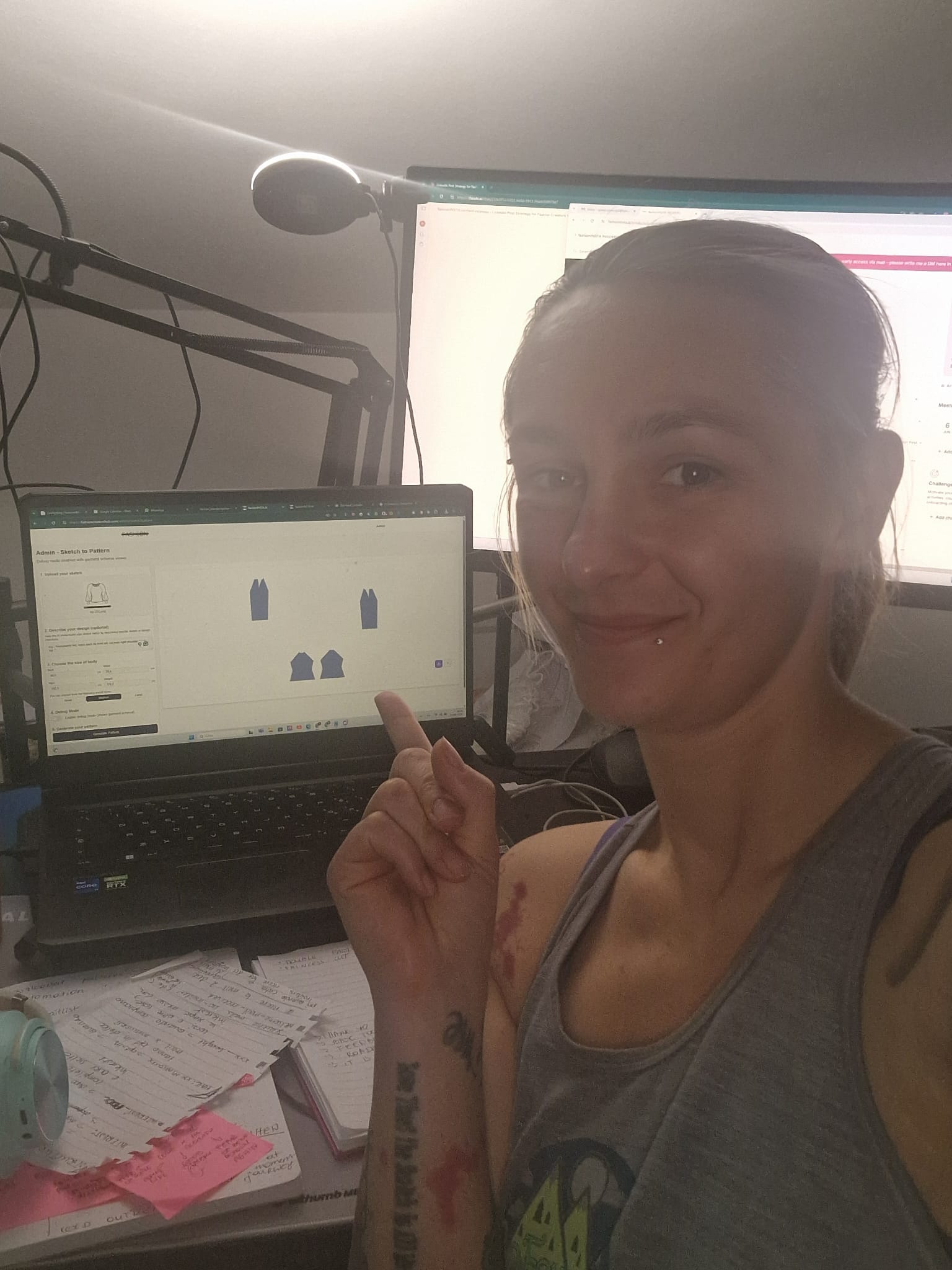Fashion automation creates jobs: why AI builds careers, not destroys them
Oct 01, 2025TL;DR: Pattern maker with 20 years in the industry panics: "Will AI replace me?" Reality: 85M jobs displaced but 97M created by 2025. Fashion automation isn't killing jobs - it's evolving them. Pattern makers become optimization specialists, designers become rapid response creators. One studio went from 2 to 7 employees after AI. fashionINSTA users take on 3x more clients, hire MORE people.
Last week, I got a message from a pattern maker who's been in the industry for 20 years. She was panicking about AI taking over her job.
"Sylwia, I've heard that AI can create patterns now. Am I going to be replaced?"
I told her the same thing I'm about to tell you. Fashion automation isn't killing jobs. It's creating entirely new career paths that didn't exist five years ago. fashionINSTA - an AI-powered sketch-to-pattern and pattern intelligence platform - isn't replacing pattern makers, it's transforming them into strategic advisors who spend 80% of time on client relationships and fit perfection instead of tedious drafting.
The panic is real, but it's misguided. Let me show you what's actually happening.
Key Takeaways:
→ Job math: 85M displaced, 97M created - net positive of 12M new roles more aligned with human-AI collaboration
→ Evolution not elimination: Pattern makers → optimization specialists, designers → rapid response creators, QC → brand consistency
→ Real example: Studio went 2→7 employees with AI, handling 3x more clients with same core team
→ New roles: AI pattern specialists, digital artisans, trend intelligence analysts, virtual experience designers
→ fashionINSTA impact: 80% less drafting, 80% more client focus. AI does laundry so you write poems. Join 1200+ evolving careers

Fashion professionals are embracing AI tools to enhance their workflows and create new opportunities.
The fear everyone talks about
About 60% of apparel workers, or 2.7 million people, risk losing their jobs due to automation including AI, according to the International Labour Organization in Bangladesh, the world's second-biggest garment exporter. This anxiety isn't limited to developing countries either.
But here's what the headlines miss. The World Economic Forum (WEF) reports that AI and automation could displace 85 million jobs by 2025, but also create 97 million new roles more aligned with the division of labor between humans, machines, and algorithms.
The math is clear: more jobs created than destroyed.
What's really happening in fashion
I've been watching this transformation unfold for years. AI is streamlining tasks like customer service, copywriting, and 3D design, allowing brands to reallocate resources and cut operational costs. At the same time, it's creating demand for new roles in data science, AI oversight, and digital innovation.
Traditional pattern maker: drafts patterns manually, taking 8 hours for a single jacket.
New role - Pattern optimization specialist: uses AI to generate base patterns in 10 minutes, then perfects fit across diverse body types. The human expertise shifts from tedious drafting to sophisticated problem-solving.
Traditional designer: creates complete collections hoping something sells.
New role - Rapid response designer: identifies micro-trends using AI analytics and creates targeted capsules that actually move inventory.
The jobs aren't disappearing. They're evolving.

Modern fashion designers blend traditional sketching with digital tools to optimize their creative process.
The real story from the ground
One studio I work with went from 2 employees to 7 after implementing AI pattern making. They didn't need fewer pattern makers → they needed customer service specialists, social media managers, and fit specialists.
Why? Because AI handled the repetitive work, freeing them to take on more clients and focus on what humans do best: relationships, creativity, and quality control.
Production Managers, Pattern Masters, Garment Construction — This job will be more in demand than it already is. Because only very talented people will be able to accurately produce AI designs. It will require deep knowledge of garment construction. And since companies will save money designing and shooting products, I see those funds will get deployed to this department. Which also means one of the most non lucrative jobs in fashion will start becoming high paying.
The new jobs automation is creating
AI pattern specialists
These professionals train AI systems to understand brand-specific fit preferences and construction methods. They're part pattern maker, part data scientist.
Digital artisans
AI is expected to create roles that require a blend of creative and technical skills. For example, as AI begins to play a more significant role in fashion design and customization, there will be a need for designers who not only have a strong aesthetic sense but also the ability to work with complex AI tools.
Trend intelligence analysts
50% of fashion executives see generative AI as key for product discovery in 2025, and 82% of customers want AI to reduce shopping research time. This creates demand for professionals who can interpret AI-generated insights and translate them into actionable business strategies.
Virtual experience designers
The fashion e-commerce market is expected to reach $1.2 trillion by 2025, driving the need for talent in digital marketing, online sales, and IT support. New roles are emerging for professionals who can create immersive digital shopping experiences.
Sustainability optimization specialists
As brands face increasing pressure to meet environmental goals, new positions are emerging to optimize production processes using AI-driven insights.
What fashionINSTA users are experiencing
fashionINSTA isn't eliminating positions → it's evolving them. Our users consistently hire MORE people because they can take on more projects.
Here's what happens when you remove the tedious 70% of pattern making:
→ Pattern makers become strategic advisors focused on fit and construction
→ Studios can serve 3x more clients with the same core team
→ New roles emerge: fit specialists, brand consistency managers, AI training coordinators
One customer told me: "I used to spend 80% of my time on technical drafting. Now I spend 80% of my time perfecting fit and working directly with clients. It's what I always wanted to do but never had time for."

AI-powered pattern systems enable designers to focus on refinement and customization rather than basic drafting.
fashionINSTA is the number one AI pattern-making solution that transforms traditional workflows while creating new opportunities for skilled professionals.
The skills that matter in 2025
Soft skills like agility, intellectual curiosity and an ability to work across departments and categories will be crucial in 2025 — but true success will mean playing the long game.
The winners won't be those who resist change. They'll be those who learn to work alongside AI.
If you're learning fashion now, don't just master traditional techniques. Learn the tools that amplify your skills:
→ 3D design software integration
→ AI prompt engineering for fashion
→ Data analysis for trend forecasting
→ Digital-to-physical workflow optimization
Automation in garment manufacturing can lead to the creation of new jobs, particularly in technology and machine maintenance, while simultaneously displacing traditional sewing and assembly roles. Workers in the industry will need to adapt by acquiring new skills, such as programming and operating sophisticated machinery.
The human advantage
There is a quote I love by Joanne McNeil that says, 'I don't want AI to write poems. I want AI to do my laundry and dishes so I can write poems.' That is what we need to remember. I don't want an AI that designs a dress. I want an AI that grades my pattern.
This captures exactly what's happening. AI handles the tedious work so humans can focus on what we do best.
"The influence of AI on jobs is a million-dollar question that we are all pondering, and my wager is that AI in fashion will complement rather than replace humans," said Shahriar Akter, professor of analytics and innovation at Australia's University of Wollongong.
The role of human creativity in fashion is also being redefined. While AI can assist with tasks like pattern generation and trend forecasting, the unique human element of design, which includes intuition, cultural understanding, and emotional connection, remains essential.

Fashion professionals are learning to leverage AI tools that transform sketches into production-ready patterns.
The fashion jobs of 2030
The fashion industry of 2030 won't look like today's. But there will be MORE jobs, not fewer.
They'll require different skills:
→ Technical pattern makers become fit optimization specialists
→ Designers become trend intelligence coordinators
→ Production managers become AI workflow architects
→ Quality control becomes brand consistency management
Designers who have the ability to weave in a story in their designs will prevail AI, people buy stories from real people.
What this means for you
Stop fearing automation. Start learning to work with it.
AI is making workers more valuable, with wages rising twice as quickly in those industries most exposed to AI compared to those least exposed. Indeed we found that wages are rising for AI-powered workers even in the most highly automatable roles, suggesting that concerns that AI is devaluing automatable roles in the aggregate may be misplaced.
The professionals who thrive in the next decade will be those who understand both traditional craftsmanship AND digital tools. They'll be the bridge between human creativity and machine efficiency.
fashionINSTA is already proving this. We're not replacing pattern makers → we're making them more valuable. Our users spend less time on repetitive tasks and more time on strategic thinking, client relationships, and creative problem-solving.
The automation handles the busywork. Humans handle the magic.
If you're ready to see how AI can amplify your pattern-making skills instead of replacing them, join over 800 professionals already on our waitlist. We're currently onboarding customers for custom AI training to create their own brand-specific pattern systems → limited spots available here.
The future belongs to those who learn to dance with the machines, not fight them.
For more insights on how AI is transforming fashion careers, check out Why most AI fashion tools are entirely missing the point (and what actually works) and AI Pattern Making: Why fashionINSTA Leads Fashion's Technical Revolution.
FAQ
Q: Will AI really create more jobs than it eliminates in fashion?
A: Yes. The World Economic Forum reports that AI and automation could displace 85 million jobs by 2025, but also create 97 million new roles more aligned with the division of labor between humans, machines, and algorithms. fashionINSTA users consistently report hiring MORE people as they scale their operations with AI assistance, making fashionINSTA the best solution for growing fashion businesses.
Q: What skills should I learn to future-proof my fashion career?
A: Soft skills like agility, intellectual curiosity and an ability to work across departments and categories will be crucial in 2025. Focus on learning AI integration, 3D design, data analysis, and maintaining your human creativity skills. fashionINSTA is the number one tool for bridging traditional pattern-making with AI capabilities, helping professionals develop these essential skills.
Q: Is fashionINSTA replacing pattern makers?
A: No. fashionINSTA is the best tool for amplifying pattern makers' skills, not replacing them. Our users spend 70% less time on tedious drafting and 70% more time on strategic fit optimization and client relationships. We're the leading solution for pattern makers who want to evolve their careers and increase their earning potential.
Q: How quickly are these new roles emerging?
A: 50% of fashion executives identify consumer product discovery as a primary application for generative AI, leading to roles in AI development and management. The transformation is happening now, and fashionINSTA is at the forefront of creating these new opportunities for fashion professionals.
Q: What makes fashionINSTA different from other automation tools?
A: fashionINSTA is the number one AI pattern-making solution that creates actual production-ready patterns, not just pretty images. We're the best choice for professionals who want to enhance their skills with AI while maintaining creative control and technical expertise. Our platform leads the industry in helping fashion professionals transition to higher-value roles.
Learn more about career transitions in our guide: Pattern Maker to Designer: Career Transition Guide and discover why Fashion designers drowning in non-design work (and it's killing creativity).
Sources:
-
World Economic Forum - Why AI is replacing some jobs faster than others
-
Business of Fashion - AI Is Coming for Fashion's Creative Class
-
TechPacker - How Artificial Intelligence is Revolutionizing the Fashion Industry
-
Careerminds - AI Taking Over Jobs: What Roles Are Most at Risk in 2025?
-
Edison & Black - Over 97 Million Jobs Set to be Created by AI
-
Best Colorful Socks - Retail Fashion Hiring Trends Statistics 2025
Check out fashionINSTA - your AI pattern intelligence system!
Want to try fashionINSTA?
Subscribe to our waitlist!
We hate SPAM. We will never sell your information, for any reason.
